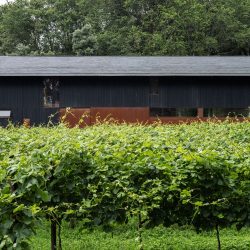
Studio Nicholas Burns . photos: © Mathyas Kurmann
On the hilly landscape of the the Minho region, in northern Portugal, sits discreetly a new winery building designed by Studio Nicholas Burns.
Located within a large family estate, this state-of-the-art winery is dedicated to the private production of the region’s typical Vinho Verde, respecting the natural cycles of the adjacent vineyard and the decade-long experience of local wine makers who have known those grapes and landscape for years.
Quinta do Mosteiro Adega is embedded in the side of the hill, where the earth provides a stable temperature allowing the ideal climate within the winery while a landscaped wall on the western side provides shade from the afternoon sun.
The Studio has been working closely with the wine makers to achieve a flawless production process based on local expertise, enhanced by a design that allows for a gravity-fed production, keeping the resulting wine pure and energetic.
The spaces are organised in two levels, connected by a double-height section. The process of wine making flows from the top to the bottom thanks to a clever use of gravity that allows the ground floor to receive the juice from the higher level. The juice then settles in tanks at the lower level, where stems and skins are separated and composted to be used back on the vineyards. The lower level, a discreet space for machinery and storage, is where the technical activity takes place. Above, at ground level, alongside a professional kitchen that doubles as a laboratory for wine testing, sit a reception area, a dining room and restrooms, allowing for social interactions and experiences.
Functionality is a priority but experience is not dismissed. Fully glazed walls allow for generous views across the estate, framed by the windows to reveal segments of landscape and trees. A careful selection of materials inspired by the surrounding forest characterises a building that is refined yet proud of its primary agricultural purpose, exhibiting simple and strong materials able to resist the test of time. In contrast, the interiors are warm, soft and elegant to reflect the ambitions of the wine produced on site.
The building is cladded in charred wood and weathered steel, while natural slate from the local area has been chosen for the roof.
The rusting steel references the other buildings on the estate and provides a robust material weathering over time, allowing the building to gently settle into the landscape and highlighting its agriculture nature. The timber – a local oak – has been charred to provide protection from the climate while the colour allows the building to blend into the shadows of the landscape, visually reducing its scale as it recedes into the hill and forest. The slate used on the roof also recalls the other buildings on the estate. The traditional roof typology is abstracted and used in a modern way, edges stretching out further, abstracting the material, thanks to a brigade steel structure and terminating with thin, elegant edges.
The interiors are calm and atmospheric, with Venetian plaster made by local artisans used on the walls and Portuguese oak on the ceiling. The plaster walls play with light and shadows, adding warmth to the agricultural building, while the oak ceiling and patterns add texture and improve the acoustics throughout.
The Erco lighting system excellently serves the winery activities and can be dimmed down and softened for dinners and more intimate gatherings. Up-lights reflect on the materials drawing down the textures and colours into the space.
The natural landscape and the built landscape are interconnected and are mutually critical to the design of the winery. No trees were removed and all the existing boulders were maintained and integrated into the building. A large granite boulder was revealed during excavation and marks the building entrance arriving from the hand-chipped stone pathway that settles into the natural landscape. The landscape is wild, bringing the forest floor down the hill and around the building in an embrace of nature to the architecture.
The temperature control provided by the landscape means there is no need for artificial climate control. The wine rooms are insulated, avoiding any refrigeration or mechanical cooling. The dark greenery and moss of the hill help maintain the perfect humidity levels while the breeze flows through the building, which enjoys natural ventilation throughout. Low vents and doors on the higher side facing the vineyard, and high vents either ends of the roof allow the air to come up through the building and to the void creating a thermal convection current releasing the air through the roof. This is assisted with mechanical vents allowing the thermal convection to still work efficiently in case of minimum contrast between the air pressures.
The winery building has been crafted with the same care needed for wine making, informed by the respect for natural processes and the surrounding landscape. It provides a space for contemplation and for gratitude, gracefully, silently nested between the hill and the vineyard. A space to connect with nature and to celebrate the simple rituals of agriculture and hospitality.
Studio Nicholas Burns has been working on the estate for years, previously on a private chapel and meditation room which is now connected to the winery through a landscaped walkway as well as a private house – Casa da Piscina, and a larger residence – Casa Principal, currently being built.
_














